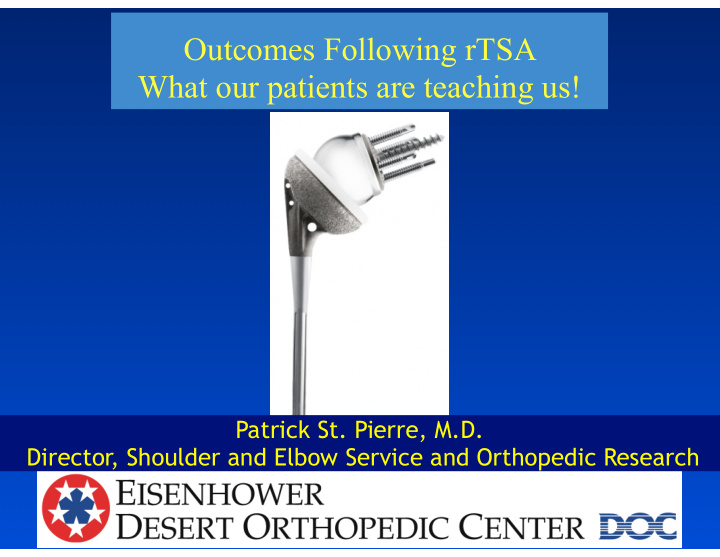



Outcomes Following rTSA What our patients are teaching us! Patrick St. Pierre, M.D. Director, Shoulder and Elbow Service and Orthopedic Research
DISCLOSURES The following rela.onships exist: 1. Royal.es and stock op.ons DJO Surgical Lippinco?, Williams & Wilkins 2. Consultant DJO Surgical Cayenne (Zimmer-Biomet) 3. Speaker Panels DJO Surgical Cayenne (Zimmer-Biomet)
Arthroplasty and in particular rTSA volumes increasing Kim et al, 2011
UTILIZATION Hemiarthroplasty -15%
UTILIZATION a TSA 5%
UTILIZATION r TSA 17%
UTILIZATION Revision 14%
Indications for Reverse Arthroplasty • Grossly deficient rotator cuff shoulder joint with severe arthropathy • Failed joint replacement with a grossly deficient rotator cuff shoulder joint • Displaced Proximal Humerus Fractures • Rheumatoid Arthritis • Massive Rotator Cuff Tears • OA with B2 glenoid and posterior wear - Walch • Glenoid bone deficiency • Elderly patients with Osteoarthritis
Comparison aTSA vs rTSA ➢ J Shoulder Elbow Surg. 2015 Feb ➢ Outcomes after shoulder replacement: comparison between reverse and anatomic total shoulder arthroplasty. Kiet TK, Feeley BT, Naimark M, Gajiu T, Hall SL, Chung TT, Ma CB. ➢ 2 yr f/u - 53 RCA - rTSA; 47 OA - TSA ➢ Complications: 15% TSA; 13% rTSA ➢ Revisions: 11% TSA; 9 % rTSA
Sports after Hemi vs. rTSA ➢ J Shoulder Elbow Surg. 2016 Jun ➢ Sports after shoulder arthroplasty: a comparative analysis of hemiarthroplasty and reverse total shoulder replacement. Liu JN, Garcia GH, Mahony G, Wu HH, Dines DM, Warren RF, Gulotta LV ➢ 102 rTSA - 71 Hemi; 1 yr; questionnaire ➢ RTSports - 85.9% r TSA; 66.7% Hemi ➢ Complaints - 29% rTSA; 63% Hemi
Reverse under 65 ➢ J Shoulder Elbow Surg. 2016 Aug ➢ Primary reverse shoulder arthroplasty in patients aged 65 years or younger. Samuelsen BT, Wagner ER, Houdek MT, Elhassan BT, Sánchez-Sotelo J, Cofield R, Sperling JW. ➢ 51 RC Arthropathy; 15 Severe OA ➢ 99% 2yr and 91% 5yr survival ➢ No difference in complications ➢ 18% Notching; 3% Instability; No loosening
rTSA Activity Level ➢ J Shoulder Elbow Surg. 2016; ➢ Younger patients report similar activity levels to older patients after rTSA. Walters JD, Barkoh K, Smith RA, Azar FM, Throckmorton, TW. ➢ 17 patients- 58 y/o; 29 patients - 75 y/o questionnaire ➢ 47% vs. 44% maintained high demand activities ➢ Concern about activity level with rTSA may be unwarranted ➢ Patients self-regulate activity
Ø 42/95 Original 5 yr Patients Ø 91% Survivorship Ø 2 revisions Ø 1 Periprosthetic Fx Ø 1 Dislocation Ø No Diminishment in ASES, ASES pain, SST
My Results rTSA results > = aTSA results ➢ Faster Recovery ➢ Equal Activity level: Golf, Tennis, Swimming ➢ Almost No Radiographic or Clinical Failures at 8 years ➢ More revisions of aTSA than rTSA patients over same time period
Radiographic Results
Rehabilitation My Philosophy • Place emphasis on patient’s role in recovery • Make it their responsibility - it’s their shoulder • Patient specific: – Independent – Self Motivated – Physically able
Rehabilitation My Mantra • Home Therapy 5 x 5 Protocol Less than 5 minutes - 5 times a day X
Home Rehabilitation • Simple Exercises that patients can follow – Safe – Effective – Reproducible – Using home equipment • < 5 minutes per session - 5 times a day
Post Operative Treatment Third Month • Continue Shoulder Range-Of-Motion (TID) – Table / Chair Slides (Warm Up) – Continue Bowing exercises • Introduce Wall Slides • Theraband Exercises – Scapular Rows – Active Deltoid Strengthening (3 Heads) • Cryotherapy after rehab
Return to Standard Physical Therapy • Failure to improve on their own – Own admission – F/U Physical exam – especially stiffness • Desire to optimize result – TSA – Rotator Cuff Repair – Return to sports (golf – tennis) Some people just love their therapist!
6 Months Postop
Shoulder Arthroplasty ➢ Reverse shoulder arthroplasty, if done well, can give equal or better results compared with anatomic arthroplasty ➢ Home Based Physical Therapy works best for most patients ➢ Allow to return to All activities as tolerated!
Thank You
Recommend
More recommend